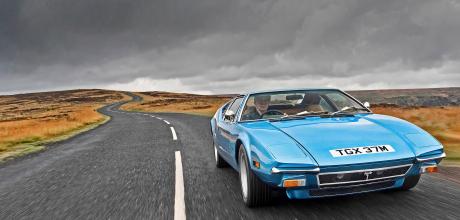1973 De Tomaso Pantera GTS
Earls Court, 1973: a supercar with Italian panache, American throb and Argentinian parentage is foisted upon an unsuspecting British public. Today we drive the British Motor Show De Tomaso Pantera GTS.
Words ROB SCORAH
Photography JONATHAN JACOB
On the road in the first De Tomaso Pantera most Brits saw
Lost in Translation Right foot down in the Earls Court Motor Show De Tomaso Pantera
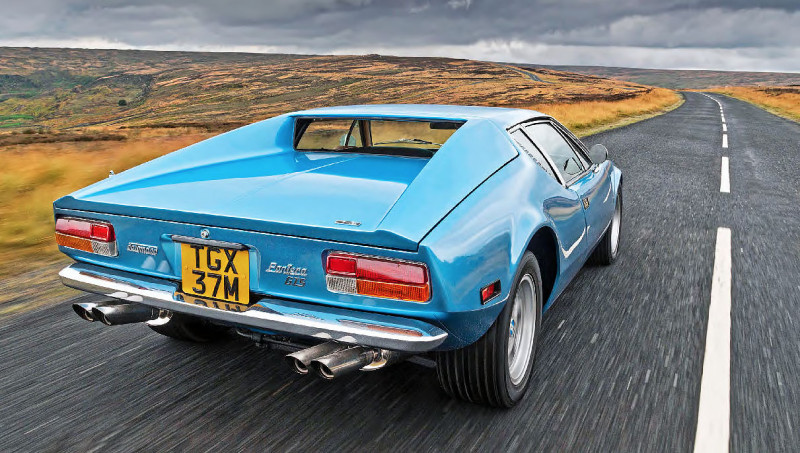
De Tomaso Pantera. Even if I hadn’t seen this ice-blue dart, I would have already been sold on the name. Try saying it slowly to yourself, overenunciating the words: D’ To-mah-so. Roll the r in Panterrra, trying to get a slight growl to it, the way its engine growls, low and muted.
To be honest, the motor’s tone has quite surprised me. It’s an American Ford V8, that’s for sure, and, as on many an AC Cobra, there’s a badge on the back to prove it – ‘Powered by Ford’. But there isn’t that guttural cough and chug of a 427 side-oiler, nor the lumpy, asymmetrical tickover of say a Big Block Ford Mustang.
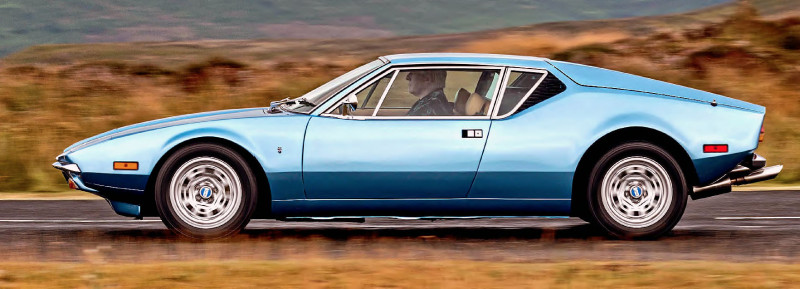
Sitting behind my shoulders, its tone has been tight and metered, never really having to raise its voice to push the car smartly from 30mph to 50. It hardens up if you go just a little further; 70mph-plus coming up quickly. Still, if you’re restrained, it remains round-edged, quite Ducati Desmosediciesque. Its sound is the first hint that, whatever idea you’ve got of the Pantera, it isn’t going to fit into anyone’s easy stereotype. What is perhaps more stereotypical is the very Seventies Italian sporting GT interior; all that blocky, square-edged leather, chromed accents and the let’s-stick-it-here school of ergonomics. Remember this is the time from when all those Italian supercar jokes originate, so yes; I’m sitting low, with my knees slightly too bent. And my arms too actually, for once. My head is brushing the roof.
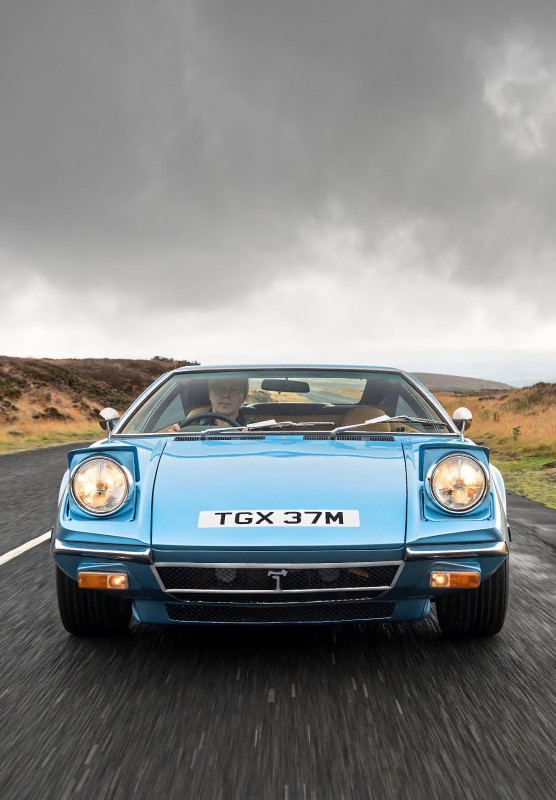
And God help you if you’re not wearing the right driving shoes; my feet are jostling for position with the pedals, pushed inwards by the inner wheel arch and the front suspension assembly. Still, it’s probably worth it for that riding-on-the-floor, ‘wearing the car’ feel And perhaps most important and iconic of all, there is that stubby wand of a gear lever set in the shining chromed claws of the gate, the shaft disappearing into the dark mysteries of the linkage below. No Italian supercar is complete without this; the satisfaction of your hand simply dropping from the rim of the steering wheel to the stout gear knob emblazoned with the Argentinian colours of Alejandro de Tomaso’s home country, along with the branding iron-like sigil of his initial.

Back in 1973, when this car took to the road, no one really had a proper idea of what it was. Okay, the model had been out for a couple of years, but who in Britain had actually seen or heard one? Before it hit the road, this car took to the stage – the De Tomaso stand at the Earls Court Motor Show of that year.
‘The snarling and the roar of the Cleveland are accompanied by the snap and clack of the metal-on-metal open gate’
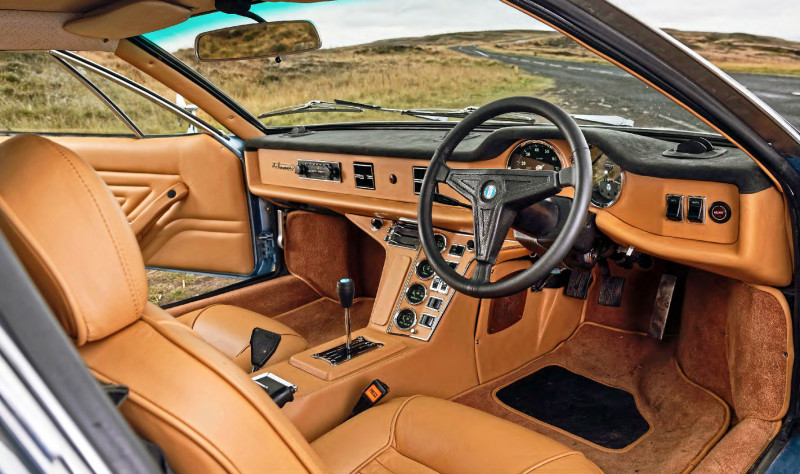
A bit like Prometheus, tycoon and car builder de Tomaso, in collaboration with Ford, was bringing down the fire of the Gods – aka the Italian supercar makers – to more ordinary mortals. In that same Earls Court show sat the new Lamborghini Countach, then scarcely more than a beefed-up concept car at £16,000, and not far away, a curvaceous, deep-blue Ferrari 365GT/4 BB for £15k. Both were V12s of course, both with their motors sitting amidships. De Tomaso offered all of that exotic mid-enginedness for between half and two-thirds the price.
‘The tarmac now a liquid stream. I’m not that sure the Pantera would ever stop’
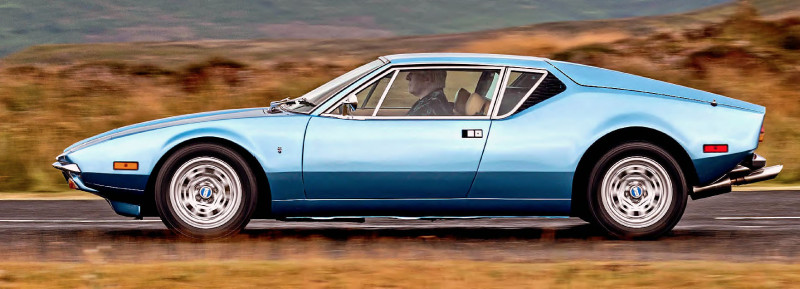
But ah, the Modena ‘purists’ might have said; an American V8 lacked the magic of those thoroughbred engines.
Sitting almost on the floor and staring down a snaking moorland road, you press your toe against the light accelerator pedal and listen to that Ducati tenor voice rise again over the basso profundo exhaust. That notion of ‘needing’ an Italian V12 generates little more than a disinterested ‘yeah, whatever’. And whatever the idea of earlier American V8s being all about lazy power and low revs, the computer-designed, five-main-bearing ‘Three-Fifty-One Cleveland’ was an all-new motor. It used higher-grade materials and had a more sophisticated and better-breathing cylinder head design than its predecessors. It was actively intended to thrive at higher revs.
You can of course still feel that, in the low revs, the torque is already there; it’s a 5.8-litre V8 for Heaven’s sake. A mile-or-more a minute is quickly dismissed even when you’re being lazy and the De Tomaso is held back at a respectable cruising speed. But the whole demeanour of the Pantera doesn’t really inculcate the cruising kind of mentality, and, with your foot gently pressing the accelerator, the car is still up on its haunches, there’s obviously so much still to go. Now try it in earnest.
After dismissing first gear – as quickly as you can; it soon holds you back – and slotting through the forward dogleg to second, you realise that the Pantera’s tacho needle is very quickly arcing beyond 3500rpm, and the machine isn’t relaxing or losing thrust. You snap back into third and the needle is back and quickly beyond 4500. The car shows no sign of relenting so you keep pushing your right foot down.
It's just past 4000rpm that the thing seems to take on a second wind of power, The growl broadens out and sharpens up, the noise flooding around your shoulders and legs as this new order of acceleration, quite distinct from the first, takes over. It’s like it has woken up to some ‘next level’ that most people never bother with and it’s gleeful that it’s found someone who will set it free. Somehow it feels even more planted on the road, guided by small, light gestures of the wrist. And there’s such an absence of roll. But, if that needle tops 5000rpm and creeps towards six, you really must have a game plan as to where you have the thing headed. Go for fourth with the slightest blip before the upchange and it just keeps charging, the road really being sucked in under the nose, under your heels and backside.
Pull back to fifth and it still carries on, the tarmac now a liquid stream. I’m not that sure the Pantera would ever stop. Many cars are fast, but there’s a ferocious relentlessness in this one that you don’t often meet (though I can hear the Aston Martin V8 Vantage saying ‘right, hold my beer’).
The snarling and the roar of the Cleveland are of course accompanied by the snap and clack of the metal-on-metal open gate. Actually though, it’s at this point that you realise that the gear stick is mainly for your entertainment and the thing itself couldn’t care less what gear it’s in. Try it; back off, let the needle wind down, stay in fifth, then plant your foot again. The roar surges forth, as does the Pantera – right back at you and arrow straight on dry tarmac, with all the exhilarating ferocity it did before, just this time without the clack-clack of the gear gate and you pretending you’re managing the power.
Talking of the ‘clack-clack’, I can’t make my mind up about that change. The ultimate in satisfaction has always been the Ferrari (perhaps even the BB); the initial resistance, a sudden submission and the smoothest follow through, all in an instant. This one is different, it’s more just ‘clack’, and I catch myself looking down at the gate a few times and I can’t work out why – then I do. It’s as if the thin wand and the claw plate are somehow operating on a different plane of movement with the linkage below, and every now and again, the gear stick bumps into the plate. It doesn’t really slow you down, but you do have to be ready for it, especially if you’re working the ’box for slow bends.
I thought you didn’t have to work the ’box? Well… slow bends are perhaps the exception. The Pantera’s natural inclination is to understeer, quite stubbornly if you try to push too hard into a tight turn. In narrow, twisty lanes, my arms seem to be doing a little too much work for the radius, and perhaps also to counter a slow-ratio rack. In a left-right-left hustle it just puts you slightly out of rhythm or balance; your shoulders not quite poised to reply to the next turn. It just gets in the way of your groove, man. Lifting off tucks the nose in without you overheating your biceps, and a lower gear keeps a nice tight poise in the throttle balance.
To be fair, by now, you’re into Lotus Elan/Europa territory where none of the bigger animals feel particularly comfortable, be that Ferrari BB, Countach or even Jaguar’s E-type (though to be honest the older Ferrari 275GTB beats the hell out of all of them here). And like those other goddesses, it’s when the De Tomaso gets onto broader roads – still winding a little for entertainment’s sake, maybe – that it feels better.
Clearing the hedgerows, the steering goes from Fifties removal van to track-car nuanced in the space of three white lines. Freed up, there’s suddenly something quite kartish in the clean, sharp responses; the car moving flat and sideways across the tarmac, guided with just small gestures of the forearms. And the whole sensation? It suddenly feels so much like a Lamborghini Miura. None of that should be a big surprise; Gian Paolo Dallara, recently lured away from Lamborghini, had designed the underpinnings to both this and the Miura. As well as its monocoque tautness, the Pantera of course had fully independent suspension all round.
Little of its handling character could be known to those eyeing it from the Earls Court floor, even potential buyers would have no more than a few magazine road tests to judge it by. This car, TGX 37M, a very original right-hand-drive model, seems to have had no trouble winning over a devoted owner, a North London building contractor who kept the car for 29 years.
In Europe, as much by inference, the Pantera was sold very much as an Italian car, the ‘Powered by Ford’ badge notwithstanding. It had the chiselled Carrozzeria Ghia looks to state its claim, although ironically, it was actually penned by a young American; Tom Tjaarda.
Over in the States, the De Tomaso Pantera was sold through Ford’s luxury Lincoln Mercury dealerships, perhaps making it seem like an in-house creation. Though I would have paid good money to watch a Lincoln Mercury salesman try to get a client out of one of their land yachts and into this.
You have to wonder what Ford – both man and firm – were thinking as it strayed from making cars it understood. The automotive behemoth was still smarting from its snubbed overtures to Ferrari, and maybe its senior management was also spooked by the mid-engined concepts (XP-882) that Zora Duntov and Chevrolet were developing and felt that the need to get ahead. Lee Iacocca, Ford’s driving force behind the Mustang, knew that it was a lot easier to corner the market if you were the first one there. And he liked the Pantera. Either way, you were – and are – left with a car that has been slightly dogged by its mixed pedigree. But make no mistake, it is a pedigree – it took great things from both parents. But it’s had to fight off competitors from both sides.
Driving the Pantera now, the engine is calling me back to its American and Anglo-American rivals. The Mustang? No; the pair may have shared an engine, but handling-wise the De Tomaso leaves the pony car for dead. By the time the Pantera landed, the old big-block Cobra was history, its nearest opponent possibly Corvette’s 425bhp ZR2 of ’71. It took no prisoners. But still no to that one. The De Tomaso feels more complex in character, a little more… subtle. I’ve got to say it; more exotic, And of course, that drives us right back to the Modena cars. Yes, you feel their pull in the De Tomaso.
In handling we’ve gone beyond the Miura, but there’s the Countach – even more guttural at times and taking the Pantera’s kart-like aspect even further. It’s more physical, more outlandish and more absurd, depending on your mood. On the Ferrari side, the new and slightly awkward 308 Dino was just emerging; great handling and a car whose V8 the Maranello engineers seemed to go to great lengths to make sound like a Coventry Climax four-pot. But there’s also that BB, equipped with that engine, a flat-12, whose multifaceted song can capture a man’s soul and make him pay out a lot of money he may not have. Their values aren’t so far apart now, and the 365/512 feels that bit longer-legged – literally so in the cabin.
But the De Tomaso’s off-the-shelf motor lent it an unexpended dimension almost alien to Modena owners’ doctrine; tuning. Where 20 Ferraris or Lambos will be ostensibly identical under the hood, it’s hard to find two Panteras alike, everything from a hotter camshaft to nitrous. Colour-coat your anti-roll bars? Yes indeed – theirs is a broad church. It’s like an Italian street rod. TGX 37M, recently overhauled by the Classic & Sports Car Centre up in North Yorkshire where it’s for sale, was gifted a ‘stroker’ kit and bigger valves (that engine was ever about valve upgrades), and no-one in the Pantera world would bat an eyelid about such things, never mind feel the need to cross themselves. There’s something great about being able to give your machine its own individual twist – assuming it’s not the frame distorting from the added torque – and something really cool about getting in amongst it with the tuners, the hot-rodders, and maybe even the NASCAR folk.
Just remember, when you go to the auto spares centre for parts and upgrades, and they ask you what it’s for, you say very clearly and with a baroque flourish of the arms, ‘It is for my De Tomaso Panterrra.’
Thanks to: Classic & Sportscar Centre, where the GTS is for sale. classicandsportscar.ltd.uk
TECHNICAL DATA 1973 De Tomaso Pantera GTS
- Engine 5763cc V8, ohv, quad-choke Autolite/ Motorcraft 4300D carburettor
- Max Power 350bhp @ 5400rpm
- Max Torque 345lb ft @ 4000rpm
- Transmission Five-speed manual, rear-wheel drive via transaxle
- Steering Rack and pinion
- Suspension Front and rear: independent, upper and lower wishbones, coil springs, telescopic dampers, anti-roll bar
- Brakes Vented discs front and rear
- Performance Top speed: 158mph
- 0-60mph: 5.5sec
- Weight 1438kg (3170lb)
- Fuel consumption 14mpg
- Cost new £7875
- Classic Cars Price Guide £36,500-£110,000

The Pantera is happiest on smooth, gradual sweepers. Cleveland throbs inches away from your shoulderblades. Peak torque at 4k, but plenty available below. Surprisingly good storage considering layout.Campagnolos crown Tjaarda’s masterpiece. Pantera was De Tomaso’s third production car. A must-have for any Seventies sports car.Ergonomically better than some Italians… just.

Such details helped define the decade. Hardly a thoroughbred; does it matter? The Ford V8 is potent, vocal and eminently tuneable. Tom Tjaarda was in his mid-Thirties when he sculpted the taut profile. Idiosyncrasies abound, but there’s also plenty to seduce a keen driver.
OWNING A DE TOMASO PANTERA GTS
Classic car enthusiast and dealer Anthony Godin owned this car as personal transport on two separate occasions. ‘I first had it back in the day when they were languishing between £35k and £40k and Ferrari Daytona values were going up and up. I remember scratching my head wondering why no-one had cottoned on to them. ‘I loved this one so much, I bought it again later. It could be so docile, it would just burble around town, and then when you gave it the beans, boy did it fly off. I’d had Ferraris and a Lamborghini [Anniversary Countach], but the Italian cars could be quite jittery. The Pantera was totally unlike them – it was in a league of its own for general use.’
He chuckles at the De Tomaso’s incongruities in design and build, ‘They’re such a contradiction; a fantastic design, and then this collection of parts. The steering wheel was off a Ford Capri, the gear knob was something else. Alejandro de Tomaso was good at building cars on a shoestring. My late father wanted one. He actually went down to the factory to see them – he said it was a tiny little place, hardly bigger than my lockup, guys walking about with body parts. He didn’t have the faith to put down a deposit.’
Godin’s own faith in the Pantera – even tired ones – is much firmer today. ‘I’m not sure you can get rear wings, though someone made the front ones for a while. The engine of course is all Ford – some stuff you can buy as blister packs. The performance you can get out of them, even when they’ve been messed around with, is phenomenal.’


